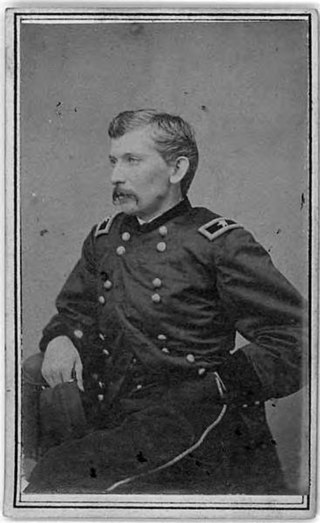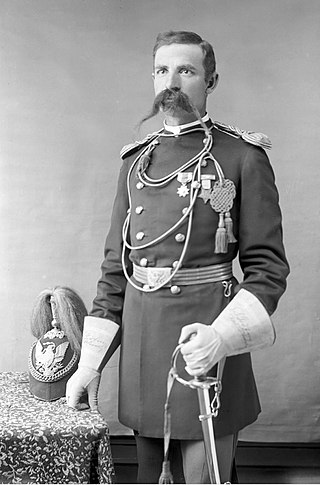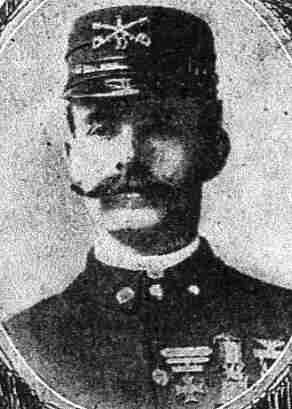
The Wounded Knee Massacre, also known as the Battle of Wounded Knee, was the deadliest mass shooting in American history, involving nearly three hundred Lakota people shot and killed by soldiers of the United States Army. The massacre, part of what the U.S. military called the Pine Ridge Campaign, occurred on December 29, 1890, near Wounded Knee Creek on the Lakota Pine Ridge Indian Reservation in South Dakota, following a botched attempt to disarm the Lakota camp. The previous day, a detachment of the U.S. 7th Cavalry Regiment commanded by Major Samuel M. Whitside approached Spotted Elk's band of Miniconjou Lakota and 38 Hunkpapa Lakota near Porcupine Butte and escorted them five miles westward to Wounded Knee Creek, where they made camp. The remainder of the 7th Cavalry Regiment, led by Colonel James W. Forsyth, arrived and surrounded the encampment. The regiment was supported by a battery of four Hotchkiss mountain guns. The Army was catering to the anxiety of settlers who called the conflict the Messiah War and were worried the Ghost Dance signified a potentially dangerous Sioux resurgence. Historian Jeffrey Ostler wrote in 2004, "Wounded Knee was not made up of a series of discrete unconnected events. Instead, from the disarming to the burial of the dead, it consisted of a series of acts held together by an underlying logic of racist domination."

The Battle of Cedar Creek, or Battle of Belle Grove, was fought on October 19, 1864, during the American Civil War. The fighting took place in the Shenandoah Valley of Northern Virginia, near Cedar Creek, Middletown, and the Valley Pike. During the morning, Lieutenant General Jubal Early appeared to have a victory for his Confederate army, as he captured over 1,000 prisoners and over 20 artillery pieces while forcing 7 enemy infantry divisions to fall back. The Union army, led by Major General Philip Sheridan, rallied in late afternoon and drove away Early's men. In addition to recapturing all of their own artillery seized in the morning, Sheridan's forces captured most of Early's artillery and wagons.

The Battle of Chaffin's Farm and New Market Heights, also known as Laurel Hill and combats at Forts Harrison, Johnson, and Gilmer, was fought in Virginia on September 29–30, 1864, as part of the siege of Petersburg in the American Civil War.

James William Forsyth was a U.S. Army officer and general. He was primarily a Union staff officer during the American Civil War and cavalry regimental commander during the American Indian Wars. Forsyth is best known for having commanded the 7th Cavalry at the Wounded Knee Massacre on December 29, 1890, during which more than 250 men, women, and children of the Lakota were killed and more than 50 were wounded.
The Battle of Honey Hill was the third battle of Sherman's March to the Sea, fought November 30, 1864, during the American Civil War. It did not involve Major General William T. Sherman's main force, marching from Atlanta to Savannah, Georgia, but was a failed Union Army expedition under Brig. Gen. John P. Hatch that attempted to cut off the Charleston and Savannah Railroad in support of Sherman's projected arrival in Savannah.

Ernest Albert Garlington was a United States Army general who received the Medal of Honor for his participation in the Wounded Knee Massacre during the Indian Wars.

The 1st West Virginia Cavalry Regiment served in the Union Army during the American Civil War. Although it started slowly, it became one of the most active and effective of the West Virginia Civil War regiments—and had 14 Medal of Honor recipients, the most for any West Virginia regiment during the war. It was originally called the 1st Virginia Cavalry, not to be confused with the Confederate 1st Virginia Cavalry. Some reports added "Union," "Loyal" or "West" when identifying this regiment. After the Unionist state of West Virginia was officially admitted to the Union in 1863, the regiment became the 1st West Virginia Cavalry Regiment. The National Park Service identifies it as the 1st Regiment, West Virginia Cavalry.
Harry LeRoy Hawthorne was a Medal of Honor recipient for his actions during the Wounded Knee Massacre.

Edward Settle Godfrey was a United States Army Brigadier General who received the Medal of Honor for leadership as a captain during the Indian Wars.

John Chowning Gresham was an officer in the United States Army who was a recipient of the Medal of Honor for his actions during the Wounded Knee Massacre as part of the Indian Wars.

Allyn Capron, was a captain in the United States Army. He commanded an artillery battery during the Wounded Knee Massacre.
Herman or Hermann Ziegner was a German-American soldier who served in the U.S. Army during the Indian Wars and the Spanish–American War. In 1891, he was one of twenty men to receive the Medal of Honor at the Battle of Wounded Knee., now called the Wounded Knee Massacre. He was also a non-commissioned officer of 71st New York Volunteer Infantry Regiment, taking part in the Santiago campaign and the charge up San Juan Hill, and was one of many regimental members who died from malnourishment and malaria prior to and shortly after returning to the United States.
Bernhard Jetter was a Kingdom of Württemberg-born soldier in the U.S. Army who served with the 7th U.S. Cavalry during the Indian Wars. He was one of twenty men who received the Medal of Honor for gallantry against the Dakota at the Battle of Wounded Knee, but now called the Wounded Knee Massacre, in South Dakota on December 29, 1890.

First Sergeant Mosheim Feaster was an American soldier in the U.S. Army who served with the 7th U.S. Cavalry during the Indian Wars. He was one of twenty men awarded the Medal of Honor for extraordinary gallantry at the Battle of Wounded Knee, but now called the Wounded Knee Massacre, on December 29, 1890. He later served in the Spanish–American War.
First Sergeant Jacob Trautman was a German-born soldier in the U.S. Army. His service included an enlistment with a Pennsylvania cavalry regiment during the Civil War and with the 7th Cavalry Regiment during the Indian Wars. He was one of twenty men who received the Medal of Honor for his actions at the Battle of Wounded Knee, now called the Wounded Knee Massacre, and afterward.
Frederick Ernest Toy was a soldier in the U.S. Army during the Indian and Spanish–American Wars; During his enlisted service, he was assigned to the 7th Cavalry Regiment until promoted to ordnance sergeant and served at a variety of posts. He received the Medal of Honor for bravery at the Battle of Wounded Knee, but now called the Wounded Knee Massacre, against the Dakota Indians on December 29, 1890. Toy retired from the Army in 1910. He was recalled and commissioned as a captain during World War I. He worked as an employment manager and as a railroad police officer.

Sergeant Paul H. Weinert was an American soldier in the U.S. Army who served with the 1st U.S. Artillery during the Indian Wars. He was one of twenty men who received the Medal of Honor for gallantry at what was then called the Battle of Wounded Knee, but now commonly called the Wounded Knee Massacre, taking charge of the battery when his commanding officer was severely wounded, on December 29, 1890.

Thomas Sullivan was a United States Army soldier and a recipient of America's highest military decoration—the Medal of Honor—for his actions in the Battle of Wounded Knee, but now called the Wounded Knee Massacre.
James Ward (1854–1901) was a United States Army soldier in the American Indian Wars and a recipient of the U.S. military's highest decoration, the Medal of Honor, for his actions at the Wounded Knee Massacre.

The 5th New York Cavalry Regiment, also known as the 5th Regiment New York Volunteer Cavalry and nicknamed the "1st Ira Harris Guards", was a cavalry regiment of the Union Army during the American Civil War. The regiment had a good fighting reputation, and had important roles in the Battle of Hanover and the Battle of the Wilderness. It was present at nearly 175 battles and skirmishes, including Gettysburg, Opequon, and Cedar Creek. A majority of its fighting was in Virginia.














